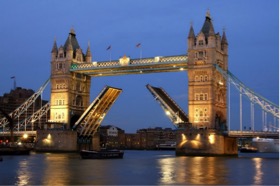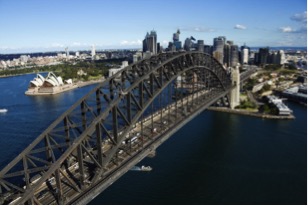Bridging Divided Cities, a Challenge to Policy-Makers and City Planners

Who will you meet?
Cities are innovating, companies are pivoting, and start-ups are growing. Like you, every urban practitioner has a remarkable story of insight and challenge from the past year.
Meet these peers and discuss the future of cities in the new Meeting of the Minds Executive Cohort Program. Replace boring virtual summits with facilitated, online, small-group discussions where you can make real connections with extraordinary, like-minded people.
For the last 200 years humankind has been going through a fundamental social and demographic change: the emergence of a planet of towns and cities. This densification of human and economic relations had to be supported with increasing connectivity and mobility infrastructure.
As places of encounters and exchanges, strategic bridges have played a major role in the worldwide urbanization process. These monuments have influenced urban development over all continents. The most fascinating cities in Europe (Paris, Rome, Istanbul, Saint-Petersburg, London) all possess fantastic bridges. The same could be said about North American cities (New York, San Francisco, Portland, Chicago, Montreal). Furthermore, the most famous bridges have always been erected at a critical juncture in the history of their host cities. We may argue that “the bridge makes the city” because, in history, the city reaches a new dimension when its “grand” bridge is inaugurated. This was verified in the cases of Prague and Florence in the fourteenth century, Mostar and Venice in the sixteenth century, Paris and Isfahan in the seventeenth century, Budapest, New York and London in the nineteenth century, and of Sydney, San Francisco, Calcutta and Shanghai in the twentieth century.
This intimate relation between cities and bridges can be illustrated by many examples. Let’s highlight ten world cities:
- Paris was the most populous city of Europe until the 18th It is built along (and divided by) the Seine River with the Ile de la Cité at its core. Its first stone bridges were built 400 years ago to link the right bank (commercial areas) and the left bank (universities). The city proper has now 38 bridges used by public transport, cars, bikes, pedestrians, etc. More than a socio-economic feature, they are a key component of the beauty and charm of the French capital.

Pont-Neuf, 1607
- Budapest did not exist as a city when its Chain Bridge across the Danube was built in 1849. Buda and Pest were facing and ignoring each other. Thanks to the magnificent bridge, Buda and Pest came together and Budapest was born in 1873. The city grew rapidly from 100,000 inhabitants in 1840 to 730,000 in 1900, reflecting a buoyant economy supported by dynamic public investments.

Chain Bridge
- New York was split into two rival boroughs, Manhattan and Brooklyn, until a genius, John Roebling, convinced conservative politicians that a bridge over the East River would benefit both banks and multiply the agglomeration efficiency. The Brooklyn Bridge, certainly the most beautiful crossing of our planet, opened in 1883 and broke all records. It transformed the agglomeration into a world-class metropolis by merging Manhattan and Brooklyn into Greater New York which soon replaced London as the most populous and powerful city in the world.

Brooklyn Bridge
- London reached its zenith during the Victorian era. The pool of London on the Thames was witnessing an enormous fluvial traffic. In 1880 it was the main port in the world. Therefore the design of Tower Bridge was controversial, the population insisting on a crossing at the East of the city while the shipping industry feared that a bridge would be a serious impediment to their business. Finally a huge neo-gothic drawbridge was approved and opened in 1894. It still constitutes an essential connection between North and South London and has been adopted as the main symbol of the city.

Tower Bridge
- Chicago was born in the mid-19th century around a heavily trafficked river. In the 1880s it was the fastest growing city of the US and the drawbridge capital of the world. As in Amsterdam, moveable bridges were a good option to allow both water traffic and land crossing. The city that invented the skyscraper had 57 drawbridges and 11 fixed bridges in 1900, it was the second most populous city in the USA. In the 21st century, bridges across the Chicago River (mostly fixed as water traffic has become essentially recreational) remain an indispensable infrastructure of downtown Chicago.

Chicago River
- Sydney, like Rio de Janeiro, is built around a superb bay but its North and South shores communicated only by ferries until 1932. This was inefficient and dangerous. The New South Wales government had agreed to build the Harbour Bridge in 1922. Ten years later the massive arch structure was opened and became immediately the icon of Australia and a symbol of its technical progress. This bridge connects two areas which by road require a ride of 50 km around the bay. Sydney took off immediately and is now a very dynamic (albeit expensive) agglomeration.

Harbour Bridge
- San Francisco, rebuilt after the 1906 earthquake, was squeezed tightly between the ocean and the bay when the New Deal mobilized a lot of investments and promoted infrastructure development all over the country. Two fantastic bridges were built simultaneously, the South-North Golden Gate (1933-37) and the West-East Bay Bridge (1933-36). The Bay Bridge linking San Francisco to Oakland transformed the bay into a large urban corridor. Recently renovated, it is absolutely vital to the regional economy.

Bay Bridge, new Eastern Span
- Calcutta, former capital of colonial India, was in deep decay when WWII started. It was the slum capital of the world, disconnected from the rest of the country, located on the East bank of the Hooghly River. By building the impressive Howrah Bridge (1943), the city was connected with the opposite bank (Howrah). This allowed a more organized growth of the agglomeration and a better access to the Indian rail network. The Rabindra Setu (its Bengali name) is considered as the most frequented (by pedestrians) bridge of the world.

Howrah Bridge
- Istanbul is a very ancient city. Established by the Greeks as Byzantium, it became Constantinople in the 4th century and Istanbul with the creation of the Turkish Republic. It is spread around two waterways. Historically Constantinople settled on both sides of the Golden Horn and later expanded on the two shores of the wide Bosphorus. While there has been a permanent bridge on the Golden Horn since 1845, the first suspension bridge on the Bosphorus (1.5 km long) was inaugurated in 1973. It was the very first transcontinental bridge in the world, linking Asia and Europe. It played an important role in the rapid expansion of the agglomeration which grew from 3.6 million inhabitants in 1975 to 14 million in 2015. The third transcontinental bridge across the Bosphorus was opened recently, in August 2016, at the mouth of the Black Sea. Istanbul region is becoming a vast urban corridor, following a Chinese development pattern.

Bosphorus Bridge
- Shanghai was a small town until the Opium wars. It grew at the end of the 19th century as a gateway to the outside world, on the West bank of the Huangpu River. Until 1990 innovative Shanghai remained relatively quiet. Then the wind of reform started to blow and new infrastructure to flourish. It was decided to urbanize the rural East bank (in Chinese: Pudong) of the Huangpu, and the initial step was to build several bridges and tunnels. The first cable-stayed bridge (Nanpu Da Qiao) opened in 1991. Metro lines followed. From 1990 to 2015 the population of Shanghai grew rapidly, from 8 million to 24 million inhabitants. Pudong – a Chinese Manhattan by its proliferation of skyscrapers – now represents a third of the agglomeration. Shanghai is clearly the economic capital of China, largely thanks to its extraordinary infrastructure.

Nanpu Bridge
Peace and development
As these few cases illustrate, bridges stitch together the urban fabric, as milestones and signatures of the built environment. As architectural objects and engineering feats, they directly reflected the technical achievements and aesthetic values of their time, as well as the socio-cultural and economic context of their construction. Urban bridges can foster peace among human beings by linking populations across waterways, and contribute to socio-economic development by providing infrastructure that is essential to production and exchange. Through proper planning, management and maintenance of cities and bridges, nations can contribute to building more harmonious societies.
Isaac Newton on walls and bridges
Between two revolutionary discoveries, the great Isaac Newton had alerted his fellow citizens with this admonition: “We build too many walls and not enough bridges.” Despite the hundreds of thousands of bridges that have been erected since the discovery of the laws of universal gravitation, Newton’s warning remains highly relevant today, particularly in the USA. Bridges among communities and physical bridges connecting urban areas have to be driven by a common concern: making our cities socially inclusive, economically prosperous and environmentally sustainable.
Discussion
Leave your comment below, or reply to others.
Please note that this comment section is for thoughtful, on-topic discussions. Admin approval is required for all comments. Your comment may be edited if it contains grammatical errors. Low effort, self-promotional, or impolite comments will be deleted.
1 Comment
Submit a Comment
Read more from MeetingoftheMinds.org
Spotlighting innovations in urban sustainability and connected technology
Middle-Mile Networks: The Middleman of Internet Connectivity
The development of public, open-access middle mile infrastructure can expand internet networks closer to unserved and underserved communities while offering equal opportunity for ISPs to link cost effectively to last mile infrastructure. This strategy would connect more Americans to high-speed internet while also driving down prices by increasing competition among local ISPs.
In addition to potentially helping narrow the digital divide, middle mile infrastructure would also provide backup options for networks if one connection pathway fails, and it would help support regional economic development by connecting businesses.
Wildfire Risk Reduction: Connecting the Dots
One of the most visceral manifestations of the combined problems of urbanization and climate change are the enormous wildfires that engulf areas of the American West. Fire behavior itself is now changing. Over 120 years of well-intentioned fire suppression have created huge reserves of fuel which, when combined with warmer temperatures and drought-dried landscapes, create unstoppable fires that spread with extreme speed, jump fire-breaks, level entire towns, take lives and destroy hundreds of thousands of acres, even in landscapes that are conditioned to employ fire as part of their reproductive cycle.
ARISE-US recently held a very successful symposium, “Wildfire Risk Reduction – Connecting the Dots” for wildfire stakeholders – insurers, US Forest Service, engineers, fire awareness NGOs and others – to discuss the issues and their possible solutions. This article sets out some of the major points to emerge.
Innovating Our Way Out of Crisis
Whether deep freezes in Texas, wildfires in California, hurricanes along the Gulf Coast, or any other calamity, our innovations today will build the reliable, resilient, equitable, and prosperous grid tomorrow. Innovation, in short, combines the dream of what’s possible with the pragmatism of what’s practical. That’s the big-idea, hard-reality approach that helped transform Texas into the world’s energy powerhouse — from oil and gas to zero-emissions wind, sun, and, soon, geothermal.
It’s time to make the production and consumption of energy faster, smarter, cleaner, more resilient, and more efficient. Business leaders, political leaders, the energy sector, and savvy citizens have the power to put investment and practices in place that support a robust energy innovation ecosystem. So, saddle up.






A case well made! Happy New Year.